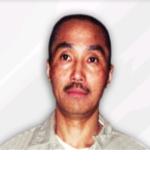Tsutomu Shirosaki is a Japanese national originally a member of Sekigun-ha (Red Army Faction). He served a prison sentence for the robberies the radical group performed in the early 1970s. He was freed in 1977 in response to the demands of JRA airline hijackers and joined the Japanese based in the Middle East. While police assert he then became an active member of the JRA, supporters claim that he acted independently of Fusako Shigenobu’s group.
Tsutomu Shirosaki was born in 1947 in central Japan. In the 1960s, he went to Tokyo University, where he received a degree in engineering. It was during his college years, where Tsutomu began participating in the student movement, embracing a more left-wing philosophy. By the 1970s, Shirosaki participated in various underground activities, including a string of bank and post office robberies. These actions were fundraising activities for Japanese radical groups. But in 1971, Shirosaki was arrested in Tokyo and sentenced to ten years in prison for an attack on a Bank of Yokohama branch office.
Flight 472 Hijack
On September 28, 1977, five members of the Japanese Red Army hijacked Japan Airlines Flight 472 in Dhaka, Bangladesh. They demanded $6 million from the Japanese government and the release of nine prisoners held in Japan. The prisoners listed included radical activists and members of the Japanese Red Army.
On October 2, six of the nine prisoners were released and taken to Dhaka. One of those prisoners released was Tsutomu Shirosaki. The released prisoners, the JRA hijackers and the remaining hostages then flew to Algeria, where the hostages were released. According to Shirosaki, the released prisoners and JRA members eventually ended up in Lebanon. After the drama of the hijacked settled, the Japanese authorities announced that the released prisoners should turn themselves into the nearest Japanese embassy. With no response from the prisoners, the Japanese government placed the freed prisoners on the Interpol wanted list.
Tsutomu Shirosaki, while choosing freedom, had no idea where to go. He had never traveled outside of Japan and spoke no other language than his own. The other freed prisoners found themselves in a similar situation. According to Shirosaki, the Japanese Red Army assisted the freed prisoners in adjusting to the new region. Despite the generosity of the JRA, Shirosaki has stated that he never joined the organization. Instead, he became a volunteer fighter in the Palestinian revolution with the Popular Front for the Liberation of Palestine (PFLP). With the Palestinian movement being so strong in Lebanon, Shirosaki did not need a passport to stay in the country.
1986 Bombing in Jakarta
On May 14, 1986, two mortar-styled rockets were fired into the U.S. Embassy compound in Jakarta, Indonesia. Then, two rockets were fired from a hotel room toward the Japanese Embassy. Also that morning, a car bomb exploded in the Canadian Embassy parking lot causing injuries to three people. A group calling itself the Anti-Imperialist International Brigade (AIIB) claimed responsibility for the action. The attacks were in response to the G7 summit in Tokyo.
Seven weeks after the incident, the Japanese government announced that they had found a fingerprint of Tsutomu Shirosaki in the hotel room where the rockets were launched at the Japanese embassy. They also claimed the Anti-Imperialist International Brigade was another named for the Japanese Red Army.
During the time of the attack, Tsutomu Shirosaki was still in Lebanon. He was not in Jakarta and was not a member of either the JRA or the AIIB. Shirosaki did not respond to the claims of his involvement because he felt they were so ridiculous. He was in Lebanon and thought that he was in a safe haven.
After the Oslo Accords, it became difficult for the Palestinian armed resistance to exist in Lebanon, so Shirosaki decided to leave. Using a false ID, he traveled to South Asia. In December of 1987, Italian authorities announced an international warrant for Tsutomo Shirosaki and another suspected Japanese Red Army member, Junzo Okudaira, for an attack on the U.S. Embassy in Rome six months earlier.
The Arrest
On September 21, 1996, local police in Kathmandu, Nepal arrested Tsutomu Shirosaki after he tried to contact some friends whose phone was tapped by the US National Security Agency. He was handed over to the FBI and extradited to the United States to stand trial. After arriving in the United States, Shirosaki stood before a 15-day trial and was sentenced to two concurrent 20-year terms and also given a 10-year term on other charges. The 20-year terms were ordered to run consecutively to the 10-year term for a total prison time of 30 years.
Tsutomu never took the stand at his own trial. He has stated he had no part in the attacks in Jakarta or membership with the Japanese Red Army or the Anti-Imperialist International Brigade. He has argued that his fingerprint had been placed at the scene. In his own words, 'I did not know that planting a copied fingerprint from a file is easy work, even in the early ’70s a corrupted policeman did, but a few years later it became clear. But I didn¹t know such information, as mentioned, I was in Japan's jail, then in Lebanon, then in South Asia, so no news about such activities.'
Deportation to Japan
He was deported to Japan in February 2015 after his prison term in the United States finished. He had served 18 years for the attack on the US embassy in the Jakarta incident, after his arrest in Nepal and extradition in 1996. He was talen into Japanese custody on February 20 and put on trial for the attack on the Japanese embassy. He was convicted and sentenced to 12 years.
Held in prison in Japan, it is believed he can only receive mail from family. He passed away in prison on July 20, 2024 at the age of 76.
Picture:

